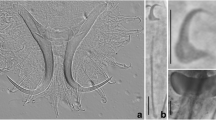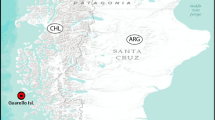Abstract
More than 60% of the spionid polychaetes recorded in South Africa to date have type localities from outside the region. One of these is Rhynchospio glutaea (Ehlers, 1897), originally described from Argentina, which was suggested to have arrived in Table Bay via shipping. Recently specimens conforming to the description of R. glutaea were collected on the south coast of South Africa from within the effluent outflow pipes from an on-shore abalone farm. The species, here named Rhynchospio mzansi n. sp., belongs to the Rhynchospio glutaea complex, and has tridentate hooded hooks that usually start on chaetiger 15–18 and up to four pairs of dorsal anal cirri. Four molecular markers confirm that the South African material is a previously undescribed species that is the most basal of the other species within the R. glutaea complex and genetically closest to R. glutaea and R. arenincola Hartmann, 1936, from the west coast of North America. This is the first species in this genus described for South Africa.





Similar content being viewed by others
References
Blake JA (1983) Polychaetes of the family Spionidae from South America, Antarctica, and adjacent seas and islands. Biology of the Antarctic seas XIV. Antarct Res Ser 39:205–288
Blake JA (1996) Family Spionidae Grube, 1850. Including a review of the genera and species from California and a revision of the genus Polydora Bosc, 1802. In: Blake JA, Hilbig B, Scott PH (eds) Taxonomic Atlas of the Benthic Fauna of the Santa Maria Basin and Western Santa Barbara Channel. Vol 6. The Annelida Part 3 - Polychaeta: Orbiniidae to Cossuridae. Santa Barbara Museum of Natural History, Santa Barbara, pp 81–223
Blake JA, Kudenov JD (1978) The Spionidae (Polychaeta) from southeastern Australia and adjacent areas with a revision of the genera. Nat Mus Vic Mem 39:171–280
Chamberlin RV (1920) The polychaetes collected by the Canadian Arctic expedition, 1913-18. Report of the Canadian Arctic Eexpedition 1913–18 9B:1–41, plates 1–6
Chlebovitsch VV (1959) Species of Polychaeta worms from the Kurile Islands, which are new or recorded for the first time in the USSR fauna. Zool Zh 38:167–181
Claparède É (1863) Beobachtungen über Anatomie und Entwicklungsgeschichte wirbelloser Thiere an der Küste von Normandie angestellt. W. Engelmann, Leipzig, pp 1–120
Claparède É (1868) Les annélids chétopodes du Golfe de Naples. Ramboz et Schuchardt, Geneva 500 pp
Claparède É (1870) Les Annélides Chétopodes du Golfe de Naples. Seconde partie. Annélides sédentaires Mémoires de la Société de physique et d’histoire naturelle de Genève. 20(1):1–225
Day JH (1961) The polychaete fauna of South Africa. Part 6. Sedentary species dredged off Cape coasts with a few new records from the shore. J Linn Soc Lond Zool 44:463–560
Day JH (1967) A monograph on the Polychaeta of southern Africa. Part 2. Sedentaria. Trustees of the British Museum (Natural History), London, 23, pp 459–841
Ehlers E (1897) Polychaeten. Ergebnisse der Hamburger Magalhaensischen Sammelreise 1892/93. L. Friederichsen & Co., Hamburg
Foster NM (1971) Spionidae (Polychaeta) of the Gulf of Mexico and the Caribbean Sea. Studies on the Fauna of Curaçao and other Caribbean Islands 36:1–183
García-Garza ME, de León-González JA, Harris LH (2017) Relocation of Dodecaseta McCammon & Stull, 1978 (Annelida, Capitellidae) in Notodasus Fauchald, 1972. ZooKeys 715:93–101
Hall T (1999) BioEdit: a user-friendly biological sequence alignment editor and analysis program for windows 95/98/NT. Nucleic Acids Symp Ser 41:95–98
Hartman O (1936) New species of Spionidae (Annelida Polychaeta) from the coast of California. Univ Calif Berkeley Publ Zool 41:45–52
Hartman O (1940) Boccardia proboscidea, a new species of spionid worm from California. J Wash Acad Sci 30(9):382–387
Huelsenbeck JP, Ronquist F (2001) MrBayes: Bayesian inference of phylogeny. Bioinformatics 17:754–755
Imajima M (1991) Spionidae (Annelida, Polychaeta) from Japan. VI. The genera Malacoceros and Rhynchospio. Bull Nat Sci Mus Tokyo, Ser A (Zoology) 17(1):5–17
Nygren A (2014) Cryptic polychaete diversity: a review. Zool Scr 43:172–183
Nylander J (2004) MrModeltest v25 https://www.researchgate.net/publication/285805344_MrModeltest_V2_Program_Distributed_by_the_Author
Radashevsky VI (2007) Morphology and biology of a new Rhynchospio species (Polychaeta: Spionidae) from the South China Sea, Vietnam, with the review of Rhynchospio taxa. J Natl Hist, Lond 41:985–997
Radashevsky VI (2015) Spionidae (Annelida) from Lizard Island, great barrier reef, Australia: the genera Aonides, Dipolydora, Polydorella, Prionospio, Pseudopolydora, Rhynchospio, and Tripolydora. Zootaxa 4019(1):635–694. https://doi.org/10.11646/zootaxa.4019.1.22
Radashevsky VI, Neretina TV, Pankova VV, Tzetlin AB, Choi J-W (2014) Molecular identity, morphology and taxonomy of the Rhynchospio glutaea Complex with a key to Rhynchospio species (Annelida, Spionidae). Syst Biodivers 12(4):424–433. https://doi.org/10.1080/14772000.2014.941039
Radashevsky VI, Malyar VV, Pankova VV, Nuzhdin SV (2016) Molecular analysis of six Rhynchospio Hartman, 1936 species (Annelida: Spionidae) with comments on the evolution of brooding within the group. Zootaxa 4127(3):579–590
Radashevsky VI, Choi J-W, Gambi MC (2017) Morphology and biology of Polydora hoplura Claparède, 1868 (Annelida: Spionidae). Zootaxa 4282(3):543–555
Rambaut A (2007) FigTree, a graphical viewer of phylogenetic trees. http://tree.bio.ed.ac.uk/software/figtree
Sars M (1851) Beretning om en i Sommeren 1849 foretagen zoologisk Reise i Lofoten og Finmarken. Nyt Mag Naturvidenskaberne 6:121–211
Sato-Okoshi W, Abe H, Nishitani G, Simon CA (2017) And then there was one: Polydora uncinata and Polydora hoplura (Annelida: Spionidae), the problematic polydorid pest species represent a single species. J Mar Biol Assoc UK 97(8):1675–1684
Sikorski A, Pavlova L (2016) Three new species of Laonice (Polychaete: Spionidae) from west and Southwest Africa. Zootaxa 4097(3):353–368
Simon CA, Sato-Okoshi W, Abe H (2017) Hidden diversity within the cosmopolitan species Pseudopolydora antennata (Claparède, 1869) (Spionidae: Annelida). Mar Biodivers. https://doi.org/10.1007/s12526-017-0751-y
Tamura K, Dudley J, Nei M, Kumar S (2011) MEGA5: molecular evolutionary genetics analysis using maximum likelihood, evolutionary distance, and maximum parsimony methods. Mol Biol Evol 28(10):2731–2739
Acknowledgements
The authors would like to thank Sandy van Niekerk for collecting the samples and processing them for scanning electron microscopy (SEM), the staff of the Central Analytical Facility (Scanning Electron Microscopy Unit) and Albe Bosman and Dylan Clark at the Iziko Museum, Cape Town for their help. Funding was provided by grants to C.A.S., from the National Research Foundation (Thuthuka: grant number 77747) and Stellenbosch University (fieldwork and SEM), and SeaKeys (molecular analysis). The authors declare that they have no conflict of interest. We also thank two anonymous reviewers for their valuable comments. All applicable international, national, and institutional guidelines for the care and use of animals were followed by the authors. Permits and approval of field or observational studies have been obtained by the authors (Permit number: RES2015-25 issued to C.A.S.).
Author information
Authors and Affiliations
Corresponding author
Additional information
Communicated by D. Fiege
This article is registered in ZooBank under urn:lsid:zoobank.org:pub:8AC21B39-16E0-4D20-AC5A-7A4F491E6A17.
The species is registered in ZooBank under urn:lsid:zoobank.org:act:69135C0D-434A-4A83-870C-5BAE9885E417.
Rights and permissions
About this article
Cite this article
Simon, C.A., Williams, LG. & Henninger, T. A new species of Rhynchospio (Annelida: Spionidae) in South Africa. Mar Biodiv 49, 663–672 (2019). https://doi.org/10.1007/s12526-017-0842-9
Received:
Revised:
Accepted:
Published:
Issue Date:
DOI: https://doi.org/10.1007/s12526-017-0842-9




